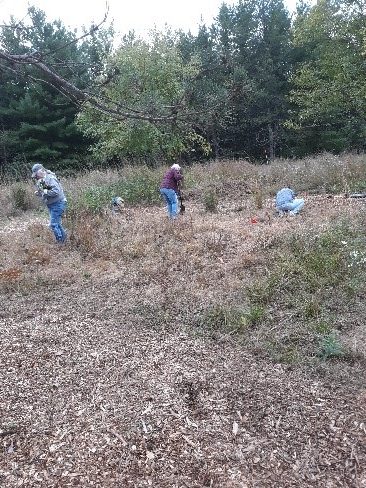Margaret Murphy
Horticulture Educator for Chippewa, Dunn, & Eau Claire Counties
UW-Madison Extension
A rain garden is a shallow depression that can be filled with a variety of flowers, sedges, and shrubs, and is designed to capture runoff from rain that lands on roofs, driveways or roads. Basically, it’s not much different from a perennial garden except that the purpose is to intercept rainwater, temporarily hold it, and release it slowly with the added benefit of removing some pollutants in the process.
As communities grow, we increase the number of impervious surfaces such as roads, parking lots, and rooftops. Impervious surfaces create barriers so that less water is able to filter through the ground. This inability of water to infiltrate the soil results in increased surface runoff both in terms of speed and volume. Stormwater runoff from these impervious surfaces carries with it chemical pollutants that can be carried directly into nearby rivers, streams and ponds. A rain garden, by soaking up rain where it falls, can slow runoff and lessen the amount ending up in our water resources.

Where to put a rain, garden is very important. Ideally, you want to take a look at your yard while it’s raining. That way you can see how runoff moves on your property. A rain garden must be located where runoff will move through it. Many rain gardens are placed at the end of a roof gutter to help buffer the runoff before reaching the street. Low spots where water pools might also be good place, however; the garden needs to drain water in a reasonable amount of time. If the water ponds long enough to kill the grass, then the spot does not allow the rain water to percolate through the soil well enough for the rain garden to function properly. A rain garden should act as a filter not as a pond.
Do not locate a rain garden within 10 feet of the house to prevent water from seeping into the basement. As there is always some excavation involved in the construction, avoid placing a rain garden under trees to keep from damaging any roots. Also, even though a rain garden is typically not very deep, always check to see if there are any utility lines in the area before you dig.

rain garden installed in the fall
Designing a rain garden is much like designing a perennial garden. The size and shape will vary depending on the landscape and the choice of plants will depend on light availability, soil type and moisture. Native wetland plants that thrive in moist to wet soils are often recommended for rain gardens. Once fully established, native plants usually require less, if any, water and fertilizer. Their deep, fibrous root system allows them to survive dry spells and also helps to filter the impurities found in rainwater runoff. Keep in mind, however, that you might need to water a rain garden during dry spells especially while the plants are getting established. Mulching will also help retain moisture and discourage weeds.
So, in summary, along with providing interest and beauty to a landscape, as almost all gardens do, rain gardens provide several environmental benefits. They reduce the amount of water flowing into storm drains, reduce the risk of flooding and lessen the amount of pollutants entering nearby water bodies.
If creating a rain garden is something that interests you, there are ample resources available to help you find the proper site, and decide on the best design and plants. Here are a couple of resources to get you started:
- Rain gardens: a guide for homeowners and landscapers: https://dnr.wisconsin.gov/topic/Stormwater/raingarden.
- Building a rain garden: https://extension.umn.edu/landscape-design/rain-gardens
To learn more about you can do to reduce stormwater runoff in your yard, visit: https://www.epa.gov/nutrientpollution/what-you-can-do-your-yard
If heading to Lake Wissota State Park this summer, visit the rain garden that was installed last year using native plants. The garden is in its infancy, so a great opportunity to watch it grow and mature over the next several years.
As always, please feel free to contact me with questions at margaret.murphy@wisc.edu or contact your local county extension office.




